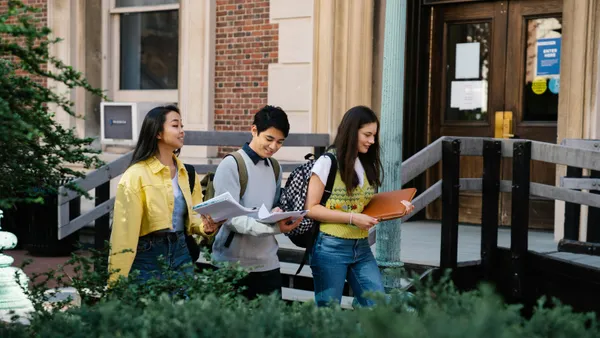Dive Brief:
-
Thirty colleges became Hispanic-serving institutions last academic year, bringing the total number of HSIs to 569, according to a recent analysis of federal data by the Hispanic Association of Colleges and Universities.
-
Around 17% of higher education institutions are now HSIs, which are schools where Hispanic students make up at least 25% of undergraduate enrollment. HACU's analysis also shows 362 schools are on the cusp of becoming HSIs, up slightly from the previous year.
-
HSIs enroll two-thirds of Hispanic undergraduates nationwide, meaning these schools must understand cultural differences among their students and help close pervasive equity gaps in educational attainment.
Dive Insight:
Hispanic students are one of the fastest-growing demographic groups in higher education. They accounted for nearly 20% of all undergraduates in the 2015-16 academic year, up from 10% a decade prior, according to an analysis of federal data by the American Council on Education.
Those trends have driven the growth in HSIs. On average, 29 schools have earned the designation each year since 2013, according to HACU.
HSIs are concentrated in certain areas of the U.S., with California and Texas — two states with large Hispanic populations — accounting for nearly 50% of them. A majority of HSIs are also in urban areas.
The label allows these schools to compete for federal grants set aside for them. But it also comes with the responsibility to create inclusive learning environments for all types of students, Mordecai Brownlee, the vice president for student success at St. Philip's College, a community college HSI in Texas, wrote in a column for EdSurge.
Brownlee gave the example of Lone Star College, a two-year school in Texas that recently won an award for its program called Mi Casa Es Su Casa, which offers support to Hispanic students. The institution, where some 50% of students are Hispanic, used a $2.6 million federal grant for HSIs to fund the program, which connects learners to tutoring, career counseling and hands-on training experiences.
These types of programs mean to boost social mobility, but deep equity gaps in postsecondary education remain. Hispanic men and women have some of the lowest educational attainment levels out of all racial and ethnic groups tracked in ACE's analysis.
Experts say colleges need to go beyond adding new programs to address the needs of this growing demographic. They should start by working on eliminating cultural biases and low expectations that can impede student success.















